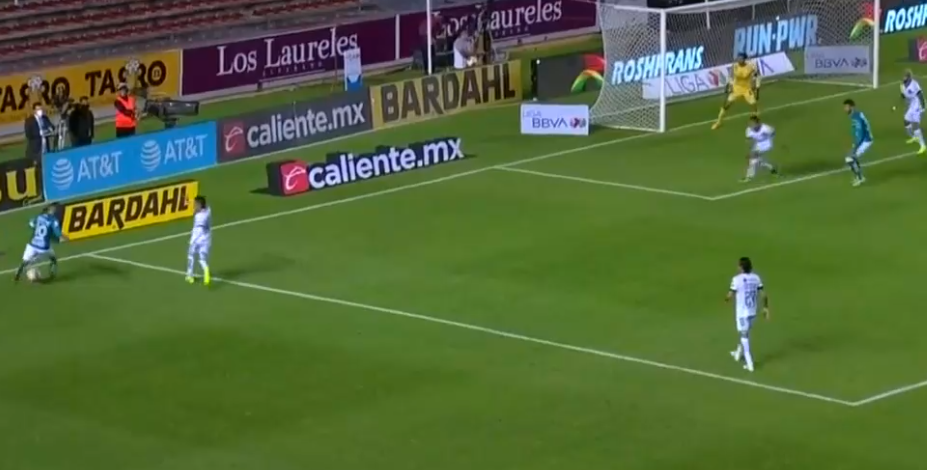- Cambio de Juego (In English)
- Posts
- Analyzing crosses in Liga MX
Analyzing crosses in Liga MX
And the importance of crossing zones
Thought: In total, 7 of the 9 teams with above-average xG figures this season, also rank above-average for the percentage of crosses from the “assist zone”. Decision making in attack is extremely important.
One of the key findings from data analysis in football regards the importance of crossing zones. Back in 2020, I produced an analysis of crossing in Liga MX, and the impact of different zones.
A historic analysis from Garry Gelade showed that only 2.22% of crosses lead to goals (taking into account direct and indirect, or second phase, goals). However, more than 7% of crosses from a zone inside or very close to the box, create goals. Also, from those zones it’s easier to play a cut-back pass and create a foot-shot, which have higher xG values (goal probability) than a headed shot.
Gelade’s crossing zones. “Zone 4” is much more effective for creating goals.
Therefore, when analyzing crosses, it’s important to differentiate between zones. I separate crosses into attempts from “zona 4” or the “assist zone” as I will refer to it in this article, or from further out from the box.
The scatter plot analyzes two important crossing concepts; frequency and zones. The metrics shown are; % of passes to the box are crosses, to see which teams prioritize crosses as an attacking strategy, and % of crosses from the assist zone.
The crosses analyzed in this article take into account high crosses, low crosses and cut-backs.

Back in February, I analyzed the efficiency of Club América’s attack, and how André Jardine’s side creates so much threat in attack without generating a high number of final third entries. This graphic is another way of visualizing their effectiveness, with a high percentage of passes into the box, and more than 55% of their crosses from the assist zone. Historically, only Nacho Ambriz’s successful sides (León and Toluca) have consistently generated around 50% of their crosses from the assist zone.
Toluca, who are ranked in 2nd behind América for xG this season, also arrive in the box through passes more frequently, and cross regularly from the assist zone.
In total, 7 of the 9 teams with above-average xG figures this season, also rank above-average for the percentage of crosses from the assist zone.
Cruz Azul’s crossing zones seem to have played a part in their drop-off in Clausura 2025. La Máquina were never too focused on crossing zones under Martín Anselmi, with Carlos Rotondi often sending-in quick crosses from wide, and more emphasis on getting good numbers into the box. However, Cruz Azul ranked around league average from assist zone crosses last season, and many teams have prevented their wide threat by defending with a back-five.
The teams that most frequently enter the box via crosses, Mazatlán and Juárez, average just one goal per game (without counting penalties), and neither have strikers that are particularly dominant in the air. Both may be able to improve their attacking productivity with a different strategy.
To understand more detail of crossing zones, I’ve created heat maps for each team.
The name below each team is the player with the highest number of crosses attempted this season, per team.

Some teams have a stronger side, when analyzing the distribution of their crosses. América, Pachuca and Querétaro generate more from the left-side, and the combination between winger Adonis Preciado and full-back Francisco Venegas has been Los Gallos Blancos’ main strength this season. The individual qualities of Brian Rodríguez and Oussama Idrissi have been important to generate crosses for their sides.
Chivas, Tigres and Toluca cross more from the right-wing. Chivas’ trend comes from a wider zone, with Alan Mozo overlapping. Whilst Alexis Vega leads Toluca for the number of crosses, part of this is due to Turco Mohamed rotating between his right-wingers and full-backs.
Tigres have increased their crossing numbers in their first matches under Guido Pizarro. They average more than 14 crosses per match under Pizarro, and Tigres didn’t get above 14 in a single game under Veljko Paunovic during Clausura 2025. The effectiveness and zones of their crosses could be key going forwards, given that Guido’s more patient style could lead to Tigres facing more low, compact blocks.
Another trend that we can observe is the distribution between crosses out wide and in the half-spaces. Atlas often cross from the half-spaces, and are the only team to have a central midfielder, Jeremy Márquez, ranking first for crosses this season. Tijuana have attempted more crosses from inside than the wings during Clausura 2025. Juan Carlos Osorio tried to build more attacks in the centre of the pitch, and left-footed Efraín Álvarez plays from the right, cutting-in to cross with his stronger foot.
Cruz Azul, Puebla, Pumas and Santos have all crossed from deeper zones on the right-wing, showing a lack of penetration on that flank. Nacho Rivero, who’s played more games this season as Cruz Azul’s right-wing-back, is more effective at attacking crosses than attempting them.
Santos don’t have the attacking right-back that Tano Ortiz needs in his play style, whilst Pumas have lacked creativity on their right-wing in recent seasons, focusing attacks on the left-side, through “Chino” Huerta or Jorge Ruvalcaba.
Near or far-post?
By analyzing crossing zones, and which players cross more frequently, we have a general idea of some of the attacking tactics across Liga MX, which can help in pre-match preparation. To amplify this process, it’s important to also consider where crosses are hit towards.
Therefore, I’ve separated successful crosses into near and far-post attempts. I’ve only take into account successful crosses, as it isn’t possible to known the intention of unsuccessful crosses (they may be overhit, or intercepted before reaching the target).
Team | % of successful crosses to the near-post |
|---|---|
Santos Laguna | 38% |
Mazatlán | 33% |
Puebla | 33% |
América | 32% |
Querétaro | 30% |
Santos is the team that attempts most crosses to the near-post, representing 38% of all of their successful crosses. Midfielders frequently arrive from deep to attack those near-post crosses, with Jordán Carrillo and Aldo López receiving eight of the 13 successful crosses.

Apart from América, the teams that have most frequently crossed to the near-post haven’t been particularly effective going forwards this season.
Team | % of successful crosses to the far-post |
|---|---|
Juárez | 31% |
Monterrey | 28% |
Tijuana | 25% |
Toluca | 24% |
Necaxa | 23% |
Juárez rank first for far-post crosses, as a percentage of all of their successful crosses. From the left, via José Luis Rodríguez or Ralph Orquín, Los Bravos have attempted more crosses from outside the assist zone, whilst they’ve crossed more from the assist zone on the right.
Graphic inspired Mark Carey/The Athletic

Whilst crosses aren’t particularly efficient in general, and there are arguments that teams should prioritize other methods of creating chances, like América or Toluca this season, crossing is still an important part many team’s attacks.
Optimizing crossing efficiency, by focusing on the most dangerous zones, the most efficient players, and space occupation in the box, is something that all head coaches and teams need to consider and work on. Also, analyzing crossing trends, and attacking decision making is a key part of pre-match preparation, in order to limit the upcoming opponent’s creativity.
Thank you for reading, if you’d like to contact me regarding any questions, comments or to consult my services, you can contact me on:
Linkedin - https://www.linkedin.com/in/thomas-harrison-a682a2175/
Twitter/X - https://x.com/tomh_36
También, se puede leer este artículo en Español- https://cambiodejuego.beehiiv.com/




